eCommerce Funnel Optimization: Everything You Need To Know In 2026

Burkhard Berger

November 3, 2025




eCommerce funnel optimization is where most online stores quietly win or lose. It is the part few talk about but everyone feels – the reason one brand’s cart stays full while another’s stays empty. Every click, every second of hesitation says something. The funnel is that story in motion, and optimization is just you editing it until nothing feels off.
This guide breaks down how to do exactly that. You will see top-performing strategies to refine different stages of your funnel and make every touchpoint feel like it belongs.
eCommerce conversion funnel optimization is the process of fine-tuning every step of your customer’s journey – from the first time they see your brand to the moment they complete a purchase (and ideally, come back for more).
Your funnel is basically your customer’s whole buying journey:
Every one of those steps can break down. Pages can load slowly. CTAs can be unclear. Discounts can be confusing. That is where you test and tweak your funnel so fewer people drop off before purchase.
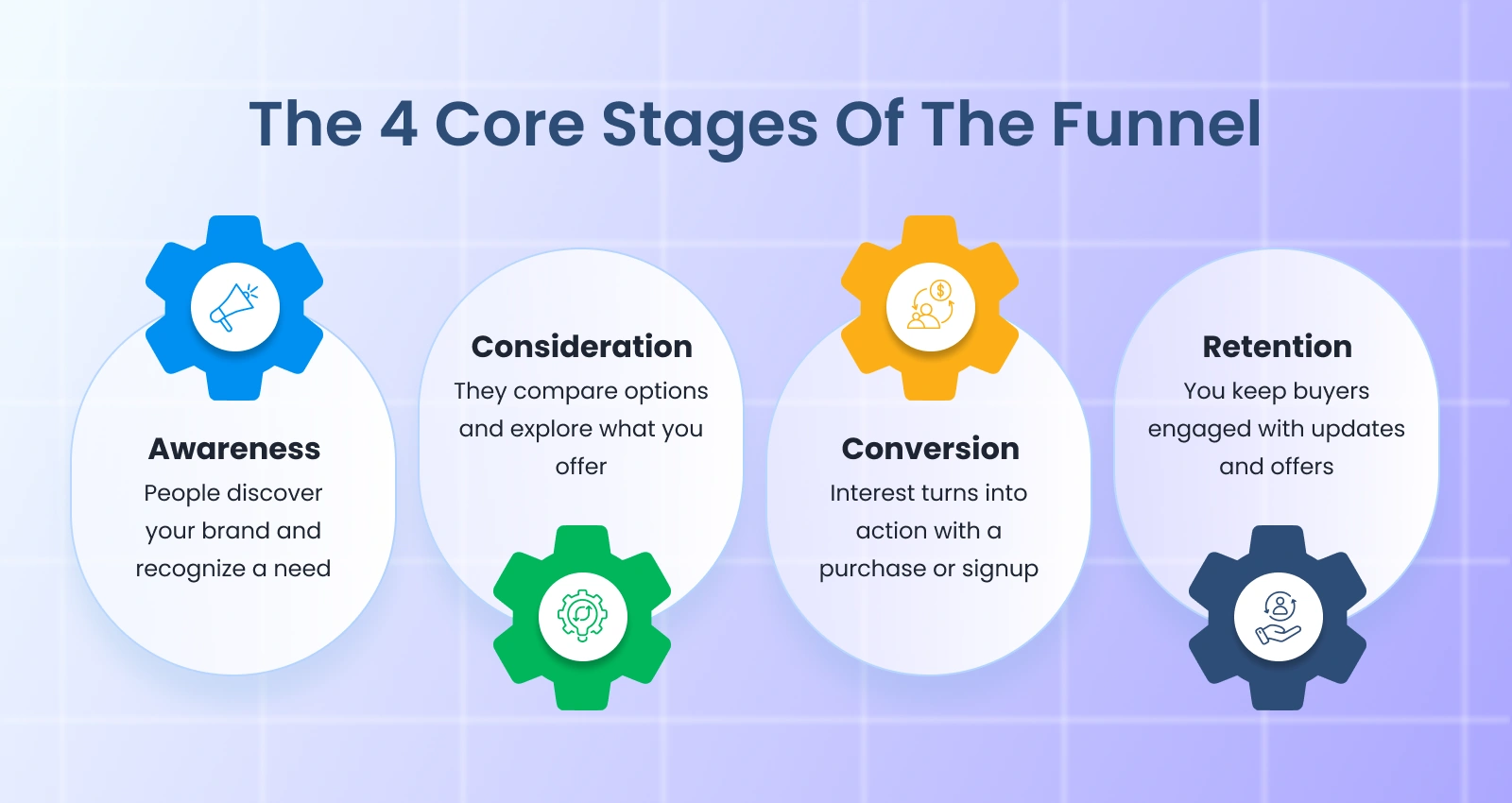
There are 4 conversion funnel stages. Let’s go through each of them.
This is where people first find you. They might see your ad or get tagged by a friend on social media. At this point:
Now they are comparing. They know they have a need, and you are one of the possible options. In this phase:
This is the buying moment – where intent becomes a real order. This stage is brutally sensitive. Even a small delay or unexpected cost can cause drop-offs. Here’s what typically happens:
Most brands stop at the sale. The best ones don’t.
Retention is all about keeping buyers engaged after purchase:
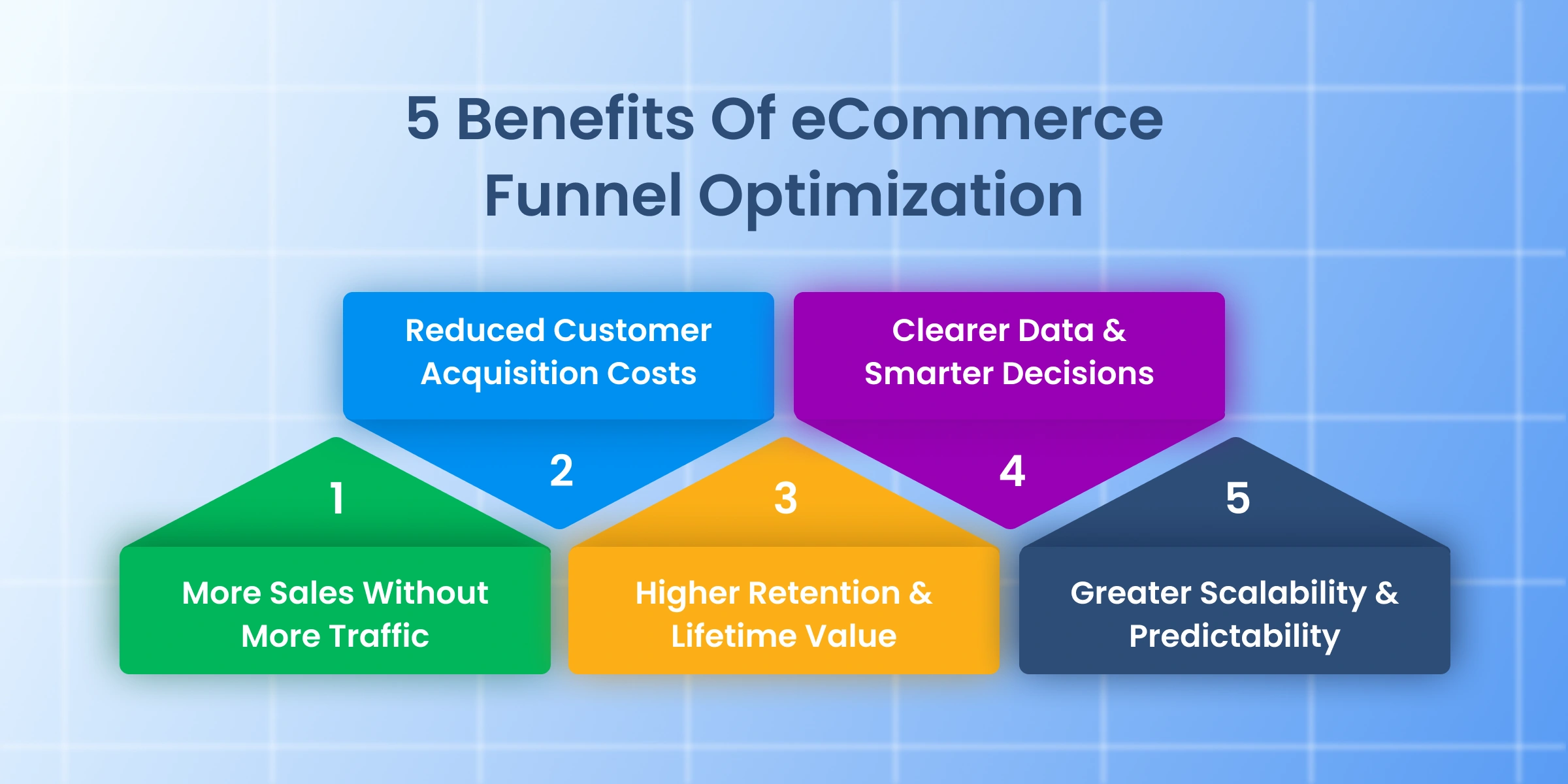
This is where most stores see the real payoff. When your funnel is optimized, everything starts working harder for you. Let’s go through the 5 big ones.
Most store owners think the answer to low sales is more ads. It is not.
If your funnel is leaking, more traffic just means more people dropping off. When you optimize your conversion funnel, you make better use of what you already have. Even a tiny increase can make a huge difference for your conversion rate optimization efforts.
For instance, if 10,000 people visit your eCommerce site and 2% buy, that is 200 orders.
Bump that to 3%, and you are at 300 orders – same traffic without spending a dollar more on ads.
When your funnel leaks less, your paid traffic spends go further. You convert more of those expensive clicks into actual paying customers.
This means you can scale ad campaigns with better ROI because you’re squeezing more value from every visitor. In short, you stop paying for “almost customers.”
An optimized funnel doesn’t just make the first sale easy – it makes the second, third, and fourth even easier.
Once someone buys, your follow-up experience decides whether they stay in your orbit. Here, optimization means:
When your retention works right, your lifetime value (LTV) jumps – and that is when scaling becomes easy on the wallet.
Optimization means you are always watching what the data says – where people drop off, what pages keep them longest, which emails get opened, which offers work. That changes everything.
So, if you see a huge cart abandonment rate, that is not random. Maybe your shipping fees show up too late, or your checkout form is too long. Metrics become a clue, and you learn from them instead of ignoring them.
A well-optimized funnel is predictable. You know your average conversion rates and average order values (AOV). And that makes it easier to forecast sales and scale campaigns.
When you don’t optimize, growth just exposes every flaw. You will send more traffic straight into the same weak spots. Do it right, and you have a funnel that scales smoothly without draining resources.
You have to get ridiculously specific about what is happening at each step of the customer journey. Let’s go through it, starting from the top.
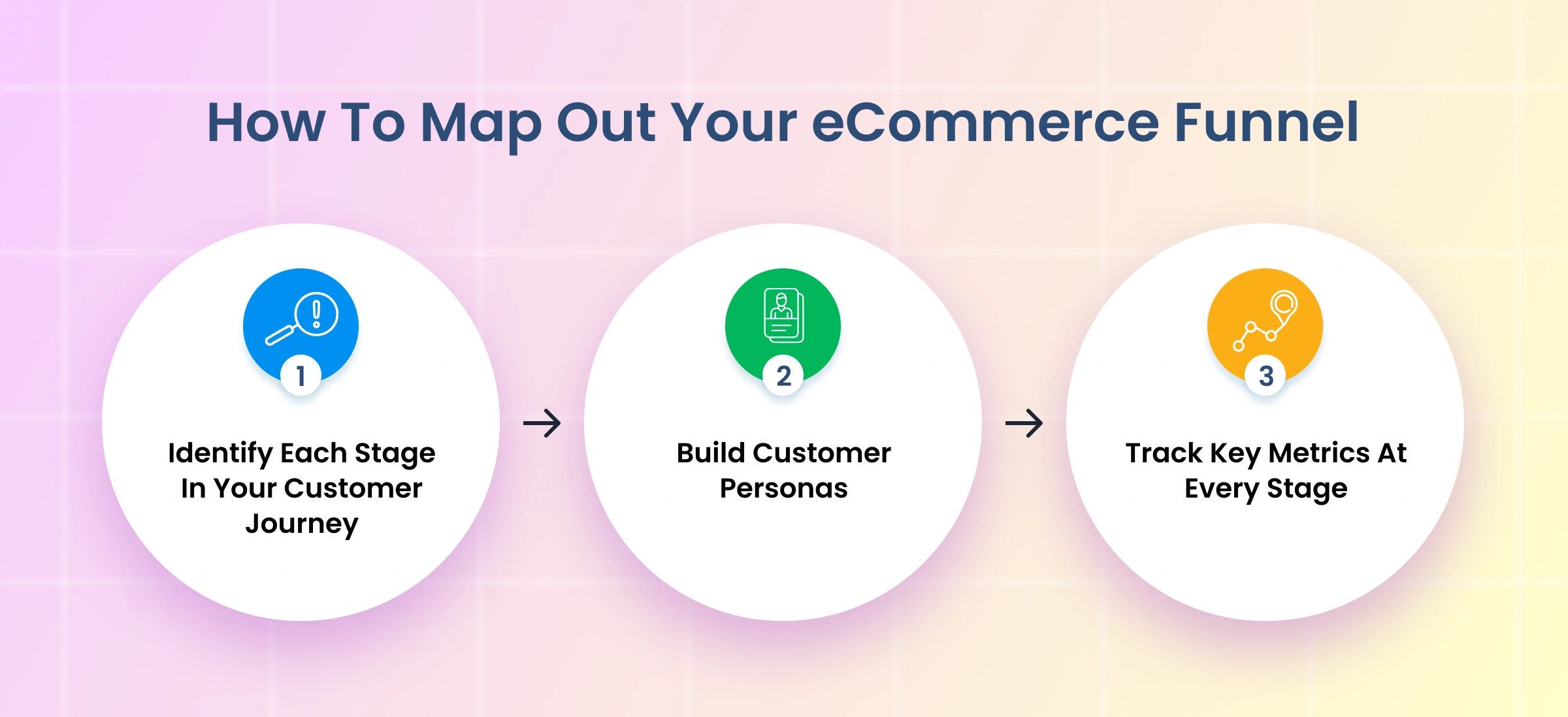
Before you touch ads or landing pages, you need a clear picture of your funnel. Most brands skip this part and start optimizing blind. Don’t.
Don’t just assume your funnel matches a textbook model – every eCommerce store has its own version. Map the path your buyers take.
Here’s what to look at:
Pro Tip: Don’t overcomplicate this. Even a simple visual funnel (awareness → consideration → checkout → repeat) works if it shows your actual traffic behavior.
Don’t guess who your funnel serves – build data-backed personas. Real ones. Even 3 strong personas can completely change how you design your funnel.
Here’s how:
Each funnel stage has its own data points — and ignoring them is why most brands keep fixing the wrong things.
Here’s are the KPIs you should track:
Know how to interpret these numbers. For instance:
At Funnelytics, we help you see your entire funnel visually. You can map every touchpoint, plug in your real traffic and conversion data, and instantly understand what is working and what is leaking.
Our visual analytics platform connects all your marketing data in one place to show you how visitors move through your funnel in real time. You will know which campaigns drive revenue, where users drop off, and how each stage actually performs.
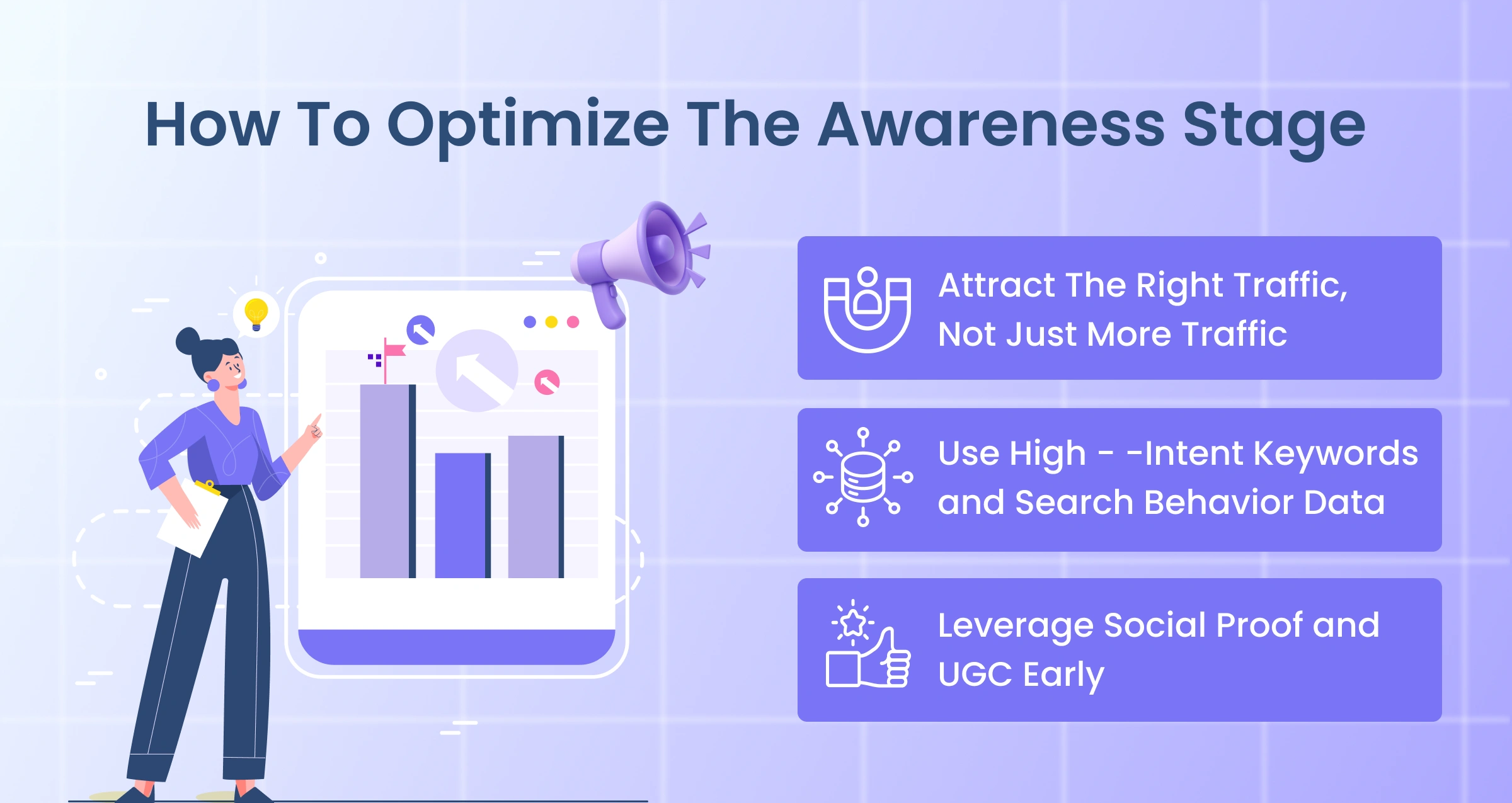
This is where most stores waste money – they push for more traffic instead of better traffic. You have to get in front of people who actually care, then give them a reason to remember you.
If your marketing funnel starts with the wrong target audience, no amount of optimization will save it. You want website visitors who already have purchase intent or a relevant problem. Quality traffic > Quantity. Always.
Here’s how to do that:
Pro Tip: Always get a Facebook Agency Ad Account instead of a standard one if you are scaling paid campaigns on Meta. It gives you higher ad spend limits and faster review times – which means your ads stay live during high-traffic periods and your optimization data keeps flowing. And that extra reliability can save thousands in lost conversions.
If SEO or Google Ads is part of your awareness mix, keyword intent is everything.
The way Google works today is heavily intent-driven. So stop chasing broad vanity terms like “shoes” – go after what people actually buy with.
Here’s the breakdown:
Use tools like Ahrefs or Google Search Console to track how people are phrasing their searches – then match your content and ads to that intent.
Pro Tip: If keyword research isn’t your strong suit, find a virtual assistant who specializes in SEO. They can pull intent data, handle competitor keyword analysis, and manage all the research you don’t have time for. It is one of those roles that quietly pays for itself. And you get to save hours and ensure your targeting always matches real buyer intent.
Social proof belongs at the start of the funnel. People believe people, so let them do the talking early.
Here’s how to direct your marketing efforts:
Pro Tip: When you are just starting to build that kind of credibility, though, it helps to build your social proof faster. And a tool like SocialPlug can make a real difference here. It helps you grow your social presence and engagement authentically, so your content gets visibility and social trust quicker.
The stronger your engagement metrics look, the easier it is for new visitors to take your brand seriously from the first scroll. And that early credibility smooths the path through the rest of your funnel.
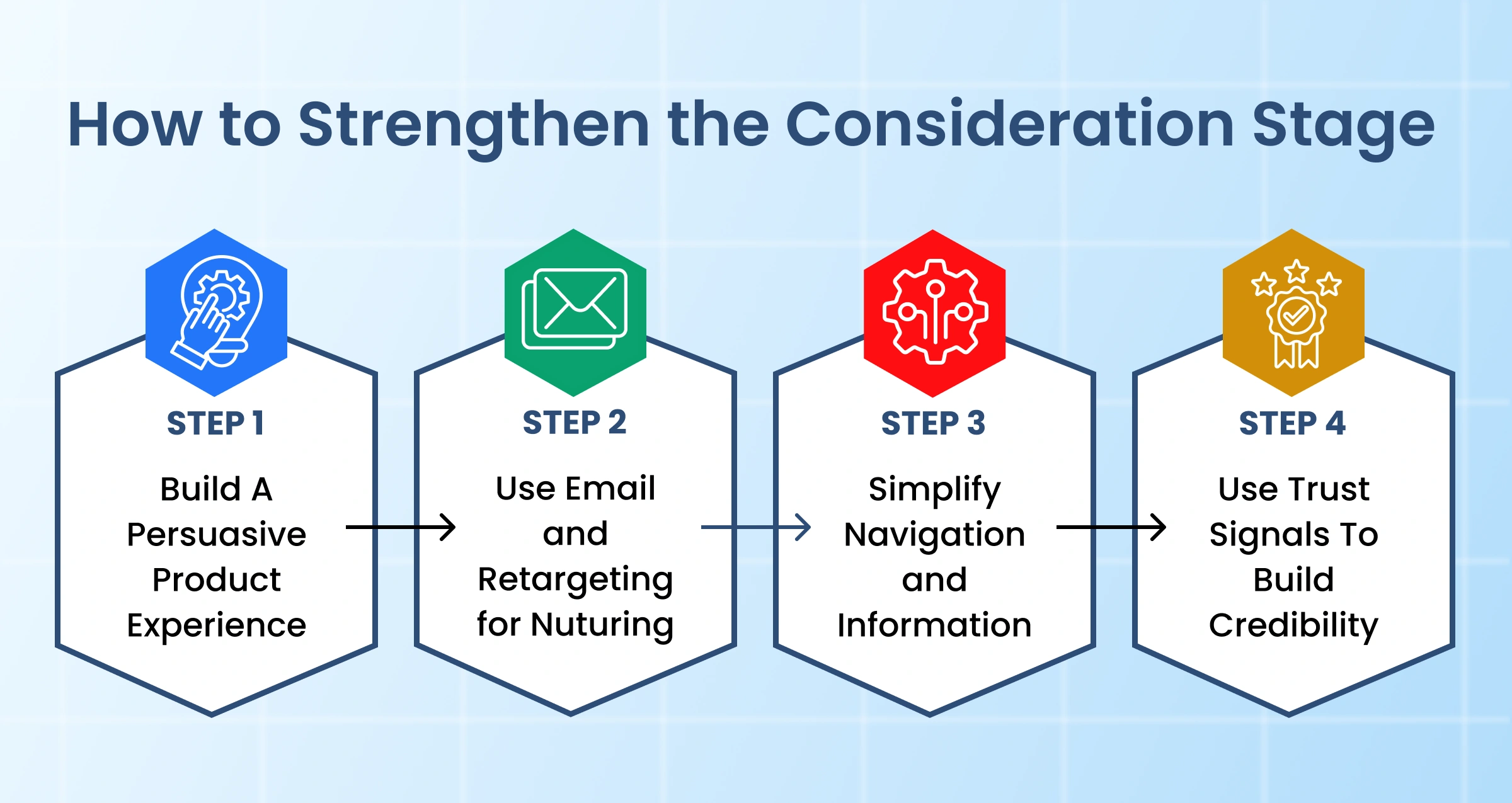
This is the “make or break” zone. At this point, people know your brand exists – but they are still comparing and trying to decide if you’re worth their money. Your job is to remove hesitation and make the decision obvious.
Your product pages are your closer. This is where people make up their mind — so treat these pages like digital sales reps. Focus on what real buyers actually care about:
Not everyone buys on the first visit – and that is fine. Most won’t. You have to smartly nurture them.
Here’s how to handle it:
If customers have to think too much, they will think themselves right out of the sale. Keep navigation so clean that even a distracted visitor can find what they need in seconds.
What to fix immediately:
At this point, buyers are asking, “Can I trust this store?” — answer that without them having to ask.
Here’s what to do:
Now, this step matters for every business, but how much it matters depends on what you sell. If you are selling phone cases or graphic tees, you can still get away with a few things unchecked here. The risk is low, and customers won’t think twice about a $10 purchase.
But if you are selling something like this high-end moissanite earrings brand, it is a whole different story. They are asking buyers to spend a few hundred dollars (sometimes more) online, without physically touching the product. That is a trust leap.
High-ticket buyers pay attention to micro-details. Miss just one of those credibility elements, and the sale can vanish instantly. Shoppers start wondering: Are these stones actually moissanite? Is the metal real? What if they don’t sparkle like the photos?
For products at that price point, trust signals are the entire foundation of conversion. Every reassurance you add closes the gap between “I want it” and “I’ll buy it.” The higher your product price, the more your store has to feel like a brand people can rely on.

Everything you have done so far leads to this moment. People have made their decision. Now they just need to finish the conversion process without surprises or doubt.
Checkout should feel effortless. Every extra field or distraction creates room for second thoughts
Here’s how to simplify it:
Over 70% of eCommerce traffic comes from mobile, but most checkouts are still built for desktops.
Here's what matters:
Scarcity works, but fake scarcity backfires fast. Shoppers are smart, so use it to inform, not manipulate.
Here's what matters:
Nothing breaks momentum like “Oh, they don’t take my payment method.” Modern shoppers expect flexibility, not limits.
Here’s the checklist:
This is where you raise your average order value (AOV) – but do it without feeling pushy.
Here’s how:
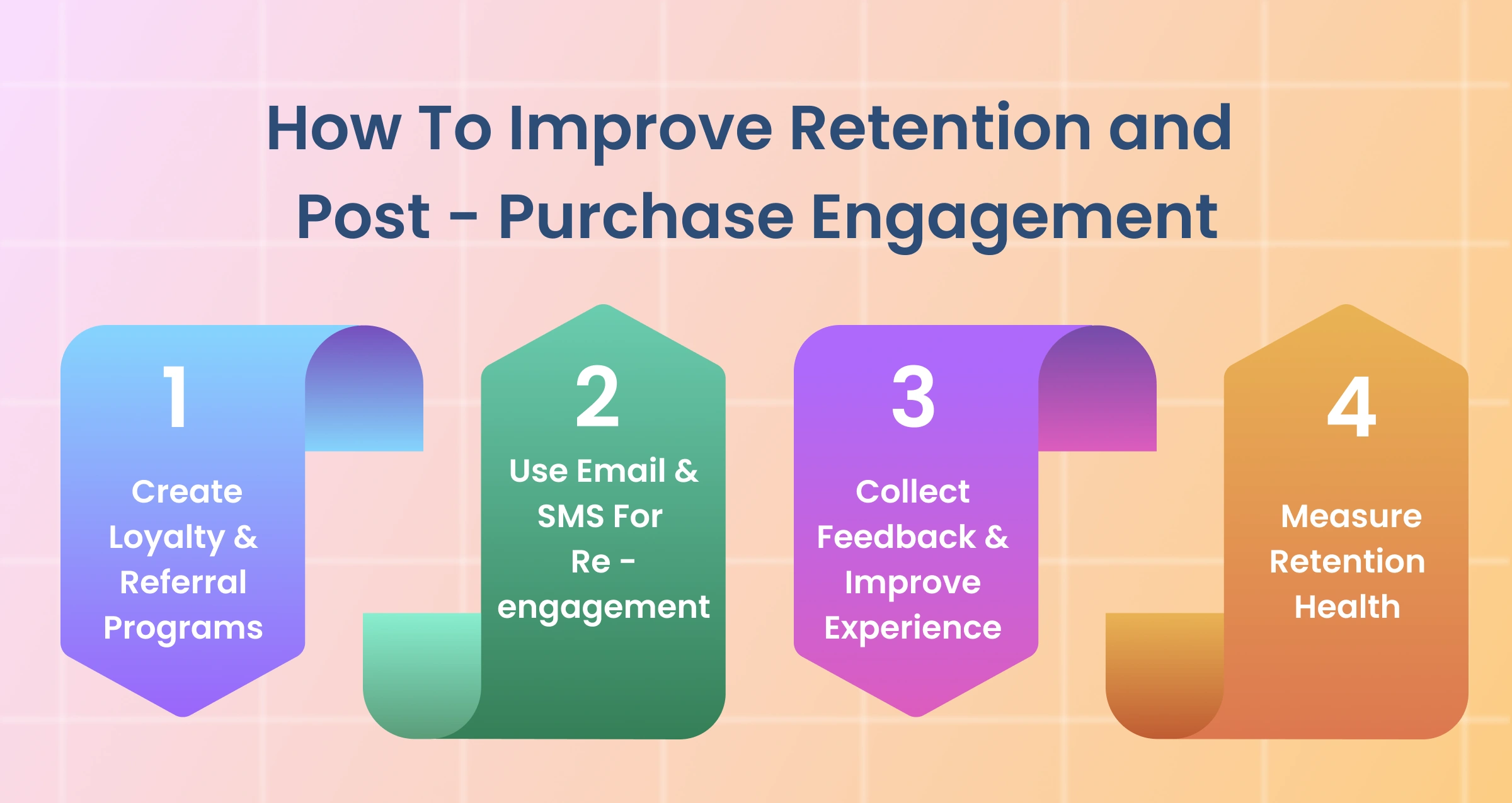
Once a customer buys, the real game starts. You have already earned their trust once – now the goal is to make coming back feel automatic. Customer retention decides how profitable your eCommerce sales funnel truly is.
Customers stick around when they feel valued, not marketed to. Rather than handing out random points, build programs that actually reward user behavior.
Here’s how to do it:
Don’t spam – nurture. The timing and message matter more than frequency.
Follow this:
Your loyal customers tell you what is broken if you ask the right way.
Here’s what to do:
Retention is measurable. If the numbers move up, your funnel is working long after checkout.
Watch these closely:
If there is one piece of advice to hold onto, make eCommerce funnel optimization part of your weekly cadence. It just needs attention. A little data cleanup here, one smoother step there – and the whole experience feels better.
Never assume what worked last quarter still works today. When your eCommerce conversion funnel runs clean and easy for prospective customers, that is when your growth starts compounding.
We built Funnelytics because we got tired of dashboards that confuse more than they clarify. It lets you map the full customer journey so you can track where your leaks are hiding and which paths are actually making money. With auto-tracking, visual journey mapping, and actionable insights, you see exactly what is working and what needs fixing.
We have both a DIY setup and a Done-For-You option (if you’d rather we handle the tech side of things). And yes – you can start a free trial or book a call with our team today, whichever works best.

Burkhard Berger is the founder of Novum™. He helps innovative B2B companies implement modern SEO strategies to scale their organic traffic to 1,000,000+ visitors per month. Curious about what your true traffic potential is?
Sign up for your free 14-day trial today and experience all the benefits Funnelytics will bring to your business first-hand. No contracts. No commitments. Just full-on customer journey insights.